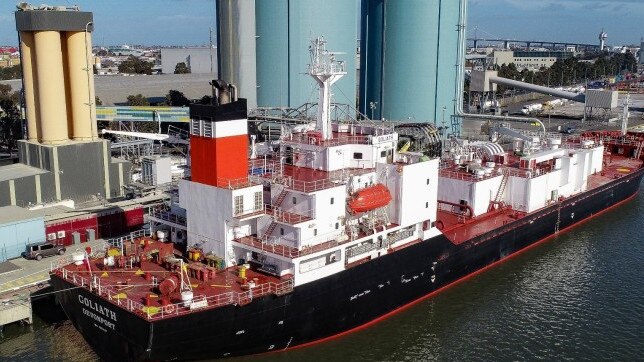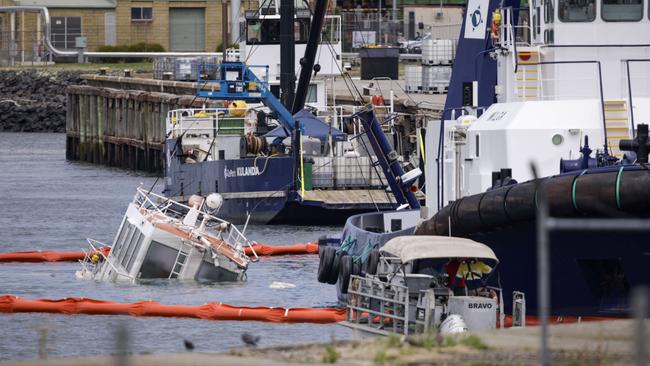Australian Transport Safety Bureau finds a steering mode error led Goliath to crash
A steering mode error caused a cement carrier to crash into the dock and sink two tugs at a Tasmanian port, the Australian Transport Safety Bureau has found. WHAT HAPPENED >>
North West Coast
Don't miss out on the headlines from North West Coast. Followed categories will be added to My News.
A PRELIMINARY report into what caused the cement carrier Goliath to crash into and sink two tugs in the Port of Devonport has found the bigger vessel’s steering was mistakenly left in manual mode.
The Australian Transport Safety Bureau released the report from its ongoing investigation into the Goliath’s collision on Thursday.
ATSB Chief Commissioner Angus Mitchell found the Goliath was not put into the VecTwin twin-rudder steering system before a joystick was used to berth the vessel in January.
The vessel had mistakenly been left in manual mode. The ship’s speed increased unexpectedly and the master placed the engine telegraph to stop but it was too late.
The report says the ship was being manoeuvred using main engine power settings, the bow thruster and a joystick to input rudder angle commands to the ship’s VecTwin steering system.
“The master felt the ship was not swinging as expected and was closing with two tugs moored at berth number Three West,” Mr Mitchell said.
“Ships fitted with the VecTwin twin-rudder steering system can be manoeuvred at low speed with thrust from the propeller re-directed as required by the two rudders, controlled by a joystick.

“The system allows astern thrust to be generated using ahead inputs on the main engine without the need to stop the engine and engaging astern propulsion, as would be required for conventional ship manoeuvring.
“With the ship’s speed unexpectedly increasing, the master checked the rudder angle indicator and found that both rudders were not at the angles corresponding to the VecTwin joystick’s ‘astern’ setting. The master called out to the second mate that the steering was not in VecTwin steering mode and immediately placed the engine telegraph to “stop”.
Goliath collided with the tug York Cove, at a speed of 4.7 knots (approximately 9 km/h).”
York Cove was moored alongside another tug, Campbell Cove. Both were severely damaged and began to take on water almost immediately.
On board Goliath, the second mate, found the steering mode selector still in manual steering mode.
Within about five hours of the collision, both tugs had sunk in about seven metres of water and were declared constructive total losses.
A salvage mission to bring them to the surface will take place this month.
Tricky salvage for sunken tugs about to launch
Two sunken tug boat wrecks in Devonport’s Mersey River will be salvaged by specialist salvage teams soon.
TasPorts said the preparatory work needed to lift the York Cove and Campbell Cove – which were sunk when a massive cement carrier hit them in January – from the river floor has largely been completed.
“Most recently, the final two chain slings for the York Cove have been secured, and the tug’s mast has been lifted onto the wharf for cutting up. The trenching and dredging of the chain paths for the York Cove has also been completed,” TasPorts said.
“Salvage barges, the 55-metre-long receiving barge, the Intan, and the 60-metre crane barge St Vincent, are expected to arrive in mid-May, subject to weather.”
After the collision, TasPorts deployed oil spill response equipment and activated its crisis response teams to stop tens of thousands of litres of fuel going into the water.

It has continued to monitor the site 24 hours a day, seven days a week focusing on maintaining the integrity of the oil spill containment area and salvaging hydrocarbons from the wrecks.
TasPorts will change the river restrictions put in place when the site is cleared.
TasPorts CEO Anthony Donald said the Mersey River was home to sensitive habitats, threatened and protected species and was popular with recreational users.
“For example, there are a number of key recreational beaches around the Port, including Coles, Bluff, Pardoe and East Devonport Beaches,” he said.
“Recreational fishing is popular in the estuary where fish commonly caught includes flathead, whiting, Australian salmon, silver trevally brown trout and blackfin bream.
“In addition, a small commercial scale fish fishery operates in the adjacent coastal areas and the entire estuary around the port is recognised as an important feeding and resting habitat for
nationally and internationally-protected migratory shore birds.
“A range of resident shore birds also inhabit the area, and little penguins are common in and around Devonport.”
Marine mammals are also often seen within and around the port include fur seals, dolphins, and occasionally whales, including the Southern Right Whale and Humpback Whale.
The Tasmanian city with plans to becoming a powerhouse
The city of Devonport has set itself a bold goal of increasing its population by almost 10,000 within two decades as it works to become the powerhouse of Tasmania’s North West.
The city, which upset its smaller neighbours recently by suggesting to a local government review that merging with Kentish and Latrobe would create economies of scale, currently has a population of almost 26,000.
A new five-star hotel is taking shape on its waterfront along with an elevated river view walkway and the city says it needs to capitalise on the economic confidence and momentum generated by its Living City initiative.
The Devonport City Council is now actively looking for new residential land on which to build more houses.
The council has called for community input for its Residential Growth Strategy which it says will provide the overarching strategic policy direction for residential growth.

Devonport Mayor Annette Rockliff said the strategy endorsed population growth targets of 30,000 by 2030 and 35,000 by 2040.
“Population growth is an important factor for cities like Devonport, and what we have is a strategy that embraces aspirational population growth to recognise and enhance Devonport’s status as the major population centre in the North-West of Tasmania,” Cr Rockliff said.
“It also helps us to continue to promote Devonport as an attractive and prominent destination to live, work and invest.“
“Following the strategic direction for residential growth endorsed through this 20-year plan, Council will continue to encourage appropriate economic development opportunities that support population growth and promote Devonport as an attractive place for investment and to facilitate increased employment opportunities.”
She said the identification of appropriate new residential land represents the major platform towards accommodating future growth.

“The greater Devonport area is not immune to the growing pressures in housing accessibility and affordability,” Cr Rockliff said.
“Increasing the supply of residential land to enable an increase in dwelling stock, and also encouraging a range of dwelling types and densities, is also considered to positively influence both housing affordability and accessibility.
“That increased supply will likely contribute towards downward pressure on these factors but the adoption of this strategy by itself will not immediately remedy land supply issues to accommodate residential growth.”
The Greater Devonport Residential Growth Strategy (2021-2041) is available via Council’s Speak Up Devonport website.




